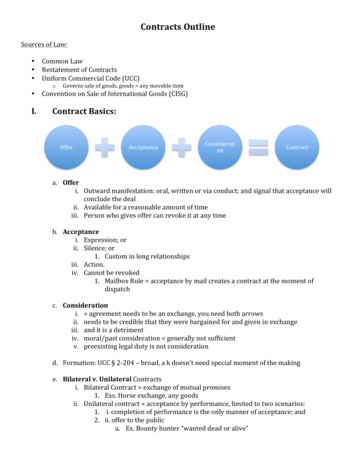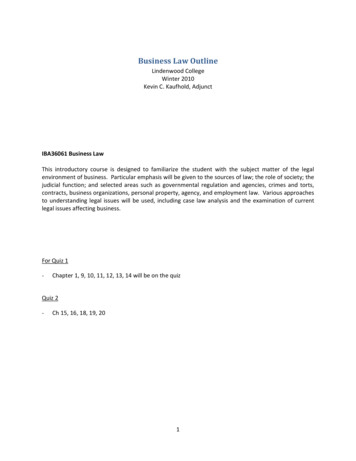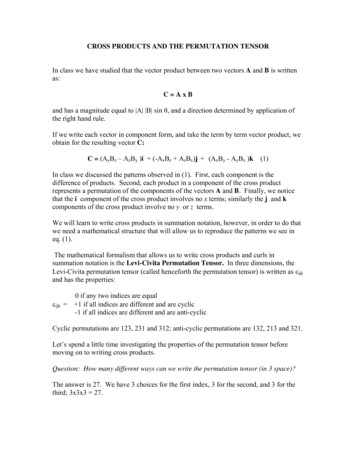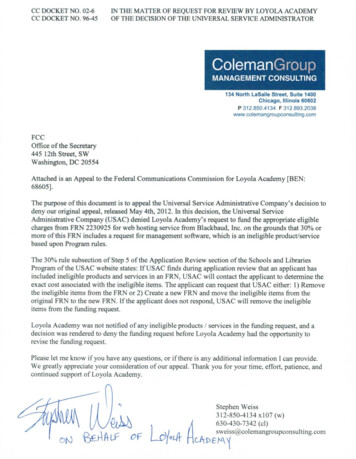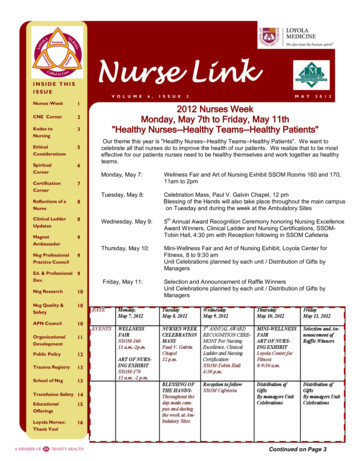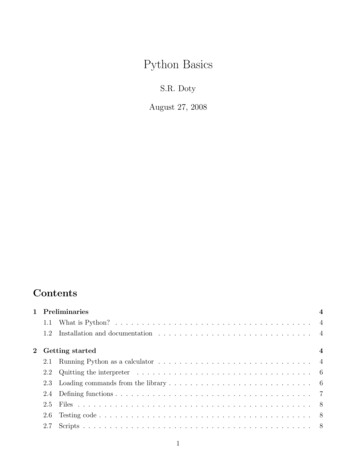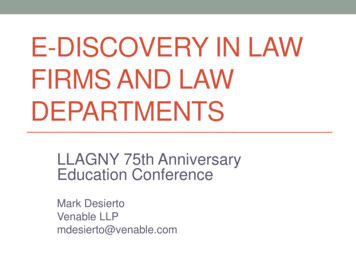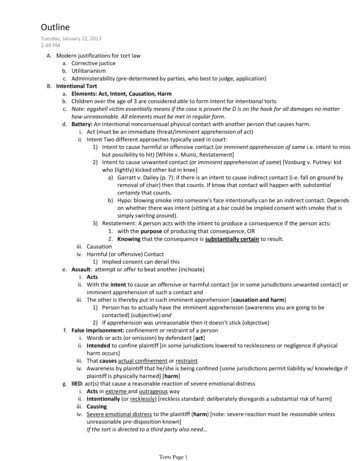
Transcription
OutlineTuesday, January 22, 20132:49 PMA. Modern justifications for tort lawa. Corrective justiceb. Utilitarianismc. Administerability (pre-determined by parties, who best to judge, application)B. Intentional Torta. Elements: Act, Intent, Causation, Harmb. Children over the age of 3 are considered able to form intent for intentional tortsc. Note: eggshell victim essentially means if the case is proven the D is on the hook for all damages no matterhow unreasonable. All elements must be met in regular form.d. Battery: An intentional nonconsensual physical contact with another person that causes harm.i. Act (must be an immediate threat/imminent apprehension of act)ii. Intent Two different approaches typically used in court:1) Intent to cause harmful or offensive contact (or imminent apprehension of same i.e. intent to missbut possibility to hit) [White v. Muniz, Restatement]2) Intent to cause unwanted contact (or imminent apprehension of same) [Vosburg v. Putney: kidwho (lightly) kicked other kid in knee]a) Garratt v. Dailey (p. 7): if there is an intent to cause indirect contact (i.e. fall on ground byremoval of chair) then that counts. If know that contact will happen with substantialcertainty that counts.b) Hypo: blowing smoke into someone's face intentionally can be an indirect contact. Dependson whether there was intent (sitting at a bar could be implied consent with smoke that issimply swirling around).3) Restatement: A person acts with the intent to produce a consequence if the person acts:1. with the purpose of producing that consequence, OR2. Knowing that the consequence is substantially certain to result.iii. Causationiv. Harmful (or offensive) Contact1) Implied consent can derail thise. Assault: attempt or offer to beat another (inchoate)i. Actsii. With the intent to cause an offensive or harmful contact [or in some jurisdictions unwanted contact] orimminent apprehension of such a contact andiii. The other is thereby put in such imminent apprehension [causation and harm]1) Person has to actually have the imminent apprehension [awareness you are going to becontacted] (subjective) and2) If apprehension was unreasonable then it doesn't stick (objective)f. False imprisonment: confinement or restraint of a personi. Words or acts (or omission) by defendant [act]ii. Intended to confine plaintiff [in some jurisdictions lowered to recklessness or negligence if physicalharm occurs]iii. That causes actual confinement or restraintiv. Awareness by plaintiff that he/she is being confined [some jurisdictions permit liability w/ knowledge ifplaintiff is physically harmed] [harm]g. IIED: act(s) that cause a reasonable reaction of severe emotional distressi. Acts in extreme and outrageous wayii. Intentionally (or recklessly) [reckless standard: deliberately disregards a substantial risk of harm]iii. Causingiv. Severe emotional distress to the plaintiff (harm) [note: severe reaction must be reasonable unlessunreasonable pre-disposition known]If the tort is directed to a third party also need i) By conduct directed to a member of plaintiff's immediate family who is present at the time orTorts Page 1
i) By conduct directed to a member of plaintiff's immediate family who is present at the time orii) To anyone else present, if they suffer bodily harmh. Trespass: unlawful entryi) Physical invasion of P's real property (act)ii) With the intent to physically invade property (intent to act to invade the property)iii) Causation (i.e. act causes invasion)iv) [harm (presumed unless intangible trespass)]i. Trespass to chattel: D intentionally interferes w/the possession of personal property thereby causing injuryi) Act (of interference w/chattel)ii) Intent to bring about interfering actiii) That causesiv) Harm (note: actual harm or removing from possession)j. Conversion: dominion or control over the chatteli) Act of serious interference w/chattelii) Intent to perform that actiii) Causediv) Harm - actual or dispossession of chattelC. Defenses to intentional tortsa. Typesi) Attack prima facie case (e.g., no intent, no contact, consent therefore not offensive)ii) Consentiii) Insanity(?)iv) Self-defense/defense of othersv) Defense of propertyvi) Necessityb. Consensual Defensesi. Explicit (no real case law) & implied (where the case law comes into play)ii. Mohr v. Williams (p. 14): if the act by D is unauthorized it is wrongful even if the D does not act withnegligence or bad intent. Note: Vosburg jurisdiction.iii. Hackbart v Cincinnati Bengals: implied consent for participating in a sport is limited to legal movesallowed by rules of game. Note: Future cases have required a showing of further reasons for recoveringincluding malice/recklessness or acts that are not part of the inherent risk in sportiv. Limits on consent1) Capacity2) Crimes (jurisdictional split & division of category of crimes).a) Ex, jurisdiction that bans duels. Participate and get stabbed. Can you sue? In some cases yesbecause you can't consent to duel b/c it is illegal. Other say no because you consented tothe crime so the consent defeats the tort. Third approach is Zysk which is that you cannotsue if you were involved in committing a crime.b) Zysk v. Zysk (handout): no recovery when harm stems from any type of illegal activity [nottrue in all states]3) Fraud: explicit statement4) Mistake?: if you know the other party believes X and it is incorrect then you have a duty to correctmistake. Not usually a defeat of consent. It rises to the level of fraud when there is the duty tocorrect mistake.5) Duress6) Scope: i.e. Mohr consent on one but not other earv. Factors in considering implied consent1) Expectations: based on conduct & words [ex, smallpox vaccine upon entry to US. She held out herarm in line so that was deemed implied consent]2) Relevant laws & statutes [ex, statutory rape laws legal determination that there is no consent]3) Custom [ex, sports activities]4) Public Policy [ex, emergency medical rule, NY subway touching]5) Revocation [ex, miners who saw unsafe conditions and decided not to stay.]c. Insanity (only a defense if defeats intent)Torts Page 2
c. Insanity (only a defense if defeats intent)i. Rule: The mentally ill are liable for intentional torts if they are capable of forming the requisite level ofintent, and do so.ii. McGuire v. Almy (p. 28): note: assumption of risk does not imply consentd. Self-Defense/Defense of others [retaliation is no defense. Defense of others would be same right as youwould have in sit.]i. Rule: what matters is what defendant reasonably (objective - not including Ds emotional characteristics)should have thoughtii. Limitations1) Must be reasonable belief that must defend self or others - reasonable mistake ok (objectivereasonability)2) No retaliation3) No provocation (as defense)4) Must be physical danger5) Duty to retreat - not required, but some jurisdictions require before using deadly force6) Excessive force: Can only be what is reasonably necessary to prevent harm to yourself or others.7) Note: defense of others is an available defense to intentional torts even if not related to individualiii. Courvoisier v. Raymond (p. 32): reasonable standard (even if two innocent actors)e. Defense of propertyi. Usually value life over property: general rule - can defend self w/force but not defend propw/"wounding" force - serious bodily injury [if feasible ask person to leave before using force]ii. Bird v. Holbrook (p. 37):1) Battery argument (prima facie case made here)2) Some states have laws that say an individual who is in the process of committing a crime in ahouse (i.e. breaking into someone's house) does not have the ability to sue for harmiii. Summary1) Can use force to repel, but not to harm2) Can't use deadly force or even wounding force to protect property3) Must ask to leave property before using any force (if feasible to do so)4) Usually must give noticef. Necessityi. Difference from other defenses - usually the P is not the wrongdoer. Frequently two innocent partiesii. Elements/requirements1) Mistake as to necessity of action is okay (if reasonable)2) Reasonableness of actions leading up to necessity irrelevant3) DO not need to make best plan under circumstances, only reasonable4) Private necessity is an incomplete defense - must pay for damages to property5) Public necessity is a complete defense [NOTE: NOT ON TEST]6) Can NOT cause substantial bodily harm to another - open question of whether can intentionallycause even slight physical harm to anotheriii. Ploof v. Putnam (p. 44): trespass defeated by necessity therefore other acts by D provides P with abilityto collect.iv. Vincent v. Lake Erie Transportation Co (p 47): necessity allows act, but individual should stillcompensate reasonable amount for damages. Makes necessity an incomplete defense.D. Negligence: behavior that unreasonably risks personal/property injury to another and causes injury (limits: fault &causation)a. Elementsi. Duty1) General rule: When a person acts, he or she must use reasonable care to avoid reasonablyforeseeable harms.a) Reasonable personb) CBAc) Customd) Negligence per see) Res ipsa loquitur (evidentiary tool)Torts Page 3
e) Res ipsa loquitur (evidentiary tool)2) Affirmative duties:a) Undertakingb) Creation of riskc) Special relationship3) Negligence per sea. Breachb. Causationi. Cause-in-fact [actual cause] &ii. Legal or proximate causec. Harmb. RP and standard of ordinary carea. RP standard: A D breaches the duty of reasonable care when, judged from the perspective of areasonably prudent person in D's position, she fails to act with reasonable care to avoid a reasonablyforeseeable risk to P. [obj standard]1) Exceptionsa) (woman?) - sometimes but usually not. Some exceptions around sexual harassment orsomething similar when gender would matter.b) Physically disabled - yes, get defense provided you're acting reasonable for someonew/your physical disabilitya. Fletcher (City removed barricades around a ditch in order to do some work andneglected to put them back up. Blind man fell in. He sued arguing the city wasnegligent. City argued RP wouldn't fall in. Court found proper standard wasreasonable blind person not reasonable sighted person)c) Mentally ill or disabled - if sudden onset get some defense, those w/lower cognitive abilitystill held to same standarda. Breunig (D hit P but claims no liability on the basis that she was mentally ill. P arguedthat she already knew she had the mental issues and therefore shouldn't have beendriving.)d) Children (exception if adult-activity where socially we want them to rise to the level of anadult as a way to encourage better behavior)a. Roberts (D was driving slowly, hit boy who darted in front of car). Negligence by Pincludes age because minor.b. Daniels: Minors driving a car are subject to same RP standard as adults.e) Special expertise or knowledge (generally only applies in instances where the specialexpertise or knowledge is known and conveyed/promised to plaintiff - a relationship basis)c. Calculus of Risk (CBA)a. The Hand Formula: use 1) probability of scenario, 2) seriousness of injury (loss) if it happens, 3)burden of precautions [B PL negligence, B PL no negligence]b. Application1) Blyth (frozen plugs): don't need to account for obscure situations2) Eckert (baby and train): can risk life to save another life if calculated risk is reasonable -- PERHAPSEVEN IF UNREASONABLE3) Osborne (paper route boy): weigh P's action along w/D's action -- PERHAPS IN SENSE OF LEASTCOST AVOIDER4) Cooley (phone, storm, traumatic neurosis): balance dangersd. Customa. Main rule: custom is some evidence of what is reasonable care but is not dispositive (TJ Hooper)b. Titus (the usual practice of the railroad was to prevent car bodies from wobbling by tying them downwith wood blocks. The decedent was a brakesman riding on top of one of these cars. The car startedwobbling and he tried to get away but was killed by the following car.): When acting according tocustom and the P has assumed some of the risk (i.e. inherently risky job), then a full defense tonegligence for acting according to custom.c. Mayhew (A mineworker's platform was modified without his knowledge, by a whole being cut into it.No railing, etc, was provided. He fell through and was injured): Limitation on custom - requiresTorts Page 4
No railing, etc, was provided. He fell through and was injured): Limitation on custom - requiresprudence (so custom doesn't provide defense w/gross negligence).d. The T.J. Hooper (Two barges were caught in a storm and were lost along with their cargo. There was anegligence claim on the basis they were not equipped w/radios and therefore did not, like other bargesin the area, avoid the storm.) Appeal: Reasonable prudence trumps even when it is not commonprudence. Custom can influence whether or not the prudence was reasonable.e. Yachts [A barge (owned by National Marine) slipped its moorings at a dock (owned by TDI) and causedabout 100K in damages. ] - in absence of agreement, court should use custom to determine duty thenallocate fault appropriately.e. Custom & medical malpractice (exception to TJ Hooper rule)a. Medical Malpractice Rule: P must establishi. Medical norm for doctors in that specialty [DUTY]ii. Departure from norm [BREACH]iii. Causationiv. Injuryb. National standard approach (current standard) (Bruen) Question is whether the physician, "if a generalpractitioner, has exercised the degree of care and skill of the average qualified practitioner, taking intoaccount the advances in the profession. In applying this standard it is permissible to consider themedical resources available to the physician as one circumstance in determining the skill and carerequired. Under this standard some allowance is thus made for the type of community with which thephysician carries on his practice " Note: this makes conforming to custom basically a completedefense.c. Emergency rule exception: held to standard of physician in same spe
b. Children over the age of 3 are considered able to form intent for intentional torts Note: eggshell victim essentially means if the case is proven the D is on the hook for all damages no matter how unreasonable. All elements must be met in regular form. c. i. Act (must
